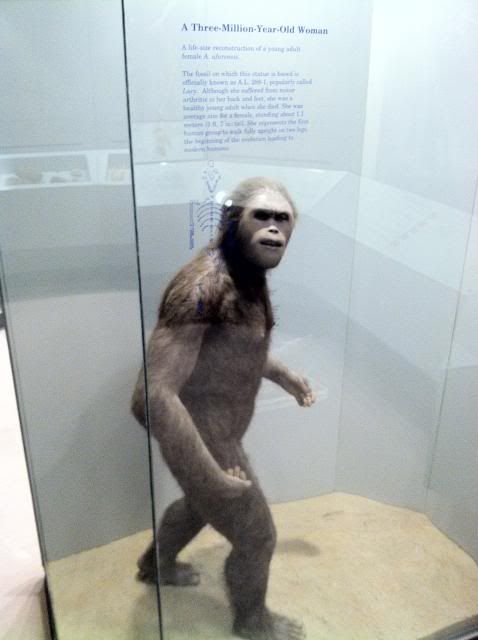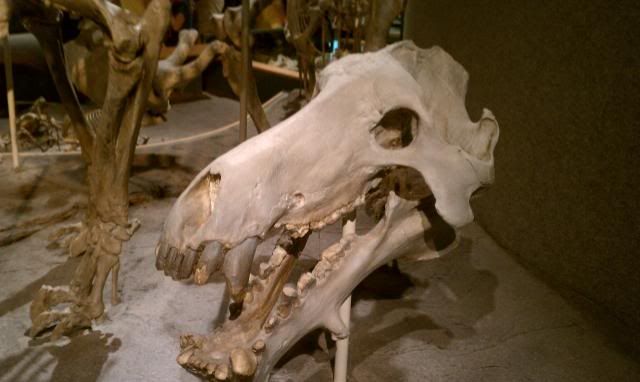Read part one and part two.
Day 3: Dinosaurs & Humans step on evolution
In this lesson, Juby recites a list of well-known and refuted creationist claims, essentially covering the Greatest Hits (complete with pictures!) from the Talk.Origins “Index to Creationist Claims.” The Talk.Origins page adequately covers the claims made in this lesson, so I will give brief rebuttals and link to the appropriate pages.
According to the scriptures, God created the dinosaurs (the land animals) on day 6 – the same day He created people. Therefore, according to the scriptures, man and dinosaurs have lived together.
Actually, there are two accounts in Genesis of the creation of humans. The first account states that humans and the other land animals were created on day six. Nevertheless, the second account claims that a god created all the life on earth and man second to last. However, after seeing that man was lonely, the god decided to create a partner for him out of one of man’s ribs.
Furthermore, humans have lived with dinosaurs for our entire existence. Birds are dinosaurs!
According to evolution, dinosaurs became extinct at least 60 million years before people ever evolved. So what would it mean if we found man and dinosaur together?
First off, non-avian dinosaurs became extinct 65 million years ago and modern humans first evolved ~200,000 years ago. Thus, Juby’s math is a little off. Second, this is not according to evolution; here Juby is equating evolution with the geological record. Third, it would mean nothing if humans and dinosaurs were found together, because humans and dinosaurs are found together (birds are dinosaurs). However, the point Juby is trying to make is what is the implication of finding evidence of humans and non-avian dinosaurs together. The only implication would be that our ideas of the extinction of all the non-avian dinosaurs 65 million years ago would be wrong and there is a problem with the geologic record. This would in no way invalidate our understanding of evolutionary theory.
Well let’s ask the evolutionists:
Dr. Richard Dawkins, one of the most outspoken atheists in the world, wrote “…there are certain things about the fossil record that any evolutionist should expect to be true. We should be very surprised, for example, to find fossil humans appearing in the record before mammals are supposed to have evolved! If a single, well verified mammal skull were to turn up in 500 million year old rocks, our whole modern theory of evolution would be utterly destroyed. Incidentally, this is a sufficient answer to the canard, put about by creationist and their journalistic fellow travelers, that the whole theory of evolution is an ‘unfalsifiable’ tautology. Ironically, it is also the reason why creationist are so keen on the fake human footprints, which were carved during the depression to fool tourists, in the dinosaur beds of Texas,” (The Blind Watchmaker, 1986, p.225, emphasis mine)
This is where I fundamentally disagree with Dawkins. It would not destroy our modern theory of evolution. It would however, throw a wrench in our understanding of the geological record, as I already said. There is far too much genetic data supporting evolutionary theory today to ever allow a field such as geology the ability to over turn it.
Juby goes on to quote two other evolutionary proponents to the same effect as above, so I see no need in repeating myself. However, I must point out that the Dawkins quote is the most recent; being from the year I was born. The other two are from before that and well before our modern understanding of genetics. This also makes me doubt that Dawkins still holds this position today, and is probably why Juby has to look to the 80s for his quotes (after all, these lessons were created in 2008).
Now we get into the Greatest Hits from Talk.Origins:
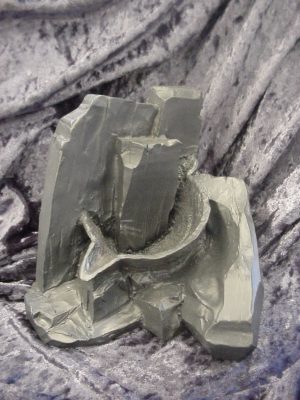
This is a replica of a cast-iron pot, found in a lump of coal supposedly 285 Million years old! This is well before the first dinosaurs were supposed to have evolved, roughly 225 million years ago.
There are only limited conclusions we can draw from such evidence:
A) Aliens were around 285 million years ago, and inadvertently dropped a pot
B) Humans were around 285 million years ago
C) The assumed age of the coal, and the assumptions of the stratigraphic record are incorrect.
D) It’s a fake.
E) It’s evidence of time travel.
Alternatively, F) the pot is of modern origins that fell into the coal mine.
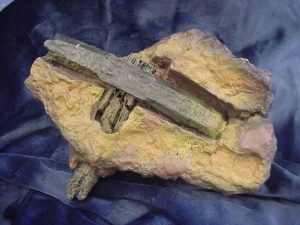
The London artifact was a hammer found in Cretaceous rocks near London, Texas. Max Hahn and his family were fishing near a waterfall when they found a rock with a piece of wood sticking out of it. They took it home as a curiousity, and broke open the rock later on to find out that the wood was actually the handle of an ancient hammer!
There’s only so many conclusions we can draw from this artifact:
A) Aliens were around during the time of the dinosaurs (the Cretaceous period), and dropped their hammer.
B) Humans were around during the time of the dinosaurs
C) The assumed age of the rock, and the assumptions of the stratigraphic record are incorrect.
D) It’s a modern hammer that got encased in old rock and fossils.
E) It’s evidence that man figured out time travel.
The anti-creationists will try and argue for “D”, though no one has produced a historic hammer that looks like this one, and this fails to explain the fossils found in the rock the hammer was encased in. It can’t be a “concretion” of fossils and rock, because there are no fossils to be found in the dirt in the riverbed the hammer was found in!
Again, F). D) is only partially correct. A historic hammer was encased in travertine. The fossils may have been reincorporated onto the concretion or they might not be fossils at all and be modern mollusks. We may never know because Don Patton does not allow actual scientists an opportunity to examine this artifact.
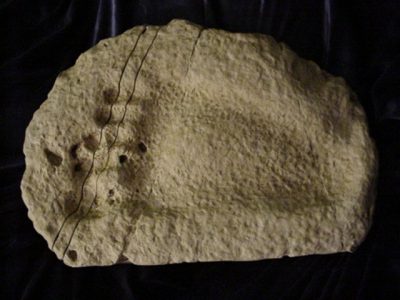
In the Paluxy riverbed in Glen Rose, Texas, literally dozens of fossil human footprints have been found amongst the dinosaur tracks that make this area so famous.
…
There’s only so many conclusions we can draw from this artifact:
A) Aliens were around during the time of the dinosaurs (the Cretaceous period)
B) Humans were around during the time of the dinosaurs
C) The assumed age of the rock, and the assumptions of the stratigraphic record are incorrect.
D) They’re from a creature other than a human being
E) It’s evidence that man figured out time travel.
F) stands for “Fake!”
Most of the fossil human footprints from the Paluxy are found in trails, excavated from underneath undisturbed limestone, in the presence of multiple witnesses.
So much for option “F”.
Once again F), for at least the example provided. The photo Juby provides is a laughable example of a forgery, which is one of the two explanations of the Paluxy River human tracks.
The fact that Juby does not see this for the obvious fraud it is speaks volumes about his knowledge of anatomy. The other explanation is misidentification of therapod dinosaur track ways, which explains the uncovering of track ways in front of witnesses. The Paluxy River is a wonderful source for dinosaur tracks. Many fossil footprints from the Paluxy River are on display at museums across the U.S.

The last picture on the right is of the Delk track, a fossil that came to light in May of 2008. This was one of several fossils that have been run through a CT scanner to check for its authenticity. I produced a video devoted just to this fossil entitled “The Delk Track: Evidence of dinosaur and human coexistence,” and it’s available for free viewing on my videos page:
http://ianjuby.org/videos.html
First, the photo provided is from his website, the one that should have appeared in the lesson does not format. However, I am familiar with the Delk Track, thus knew what it looked like. Second, this is the one example Juby uses that does not appear on Talk.Origins “Index to Creationist Claims.” Nevertheless, Glen J. Kuban has written up a superb refutation of the Delk Track entitled “The Alvis Delk Print: An Alleged Human Footprint on a Loose Rock” wherein Kuban refutes everything about this forgery, including an explanation of how the human and dinosaur prints are fakes. I encourage everyone that has not already read his article to please read it. It is well worth your time.
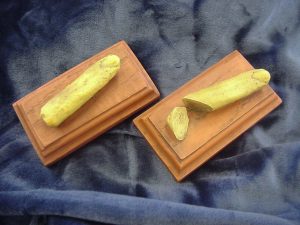
Perhaps you’re still not convinced those are human tracks? Well not far from Glen Rose, during the construction of the Comanche peak nuclear power plant, a gravel layer, sandwhiched between two layers of the Walnut shale, was cut through. This fossil human finger was found amongst the gravels.
Unbelievably Juby (and his creationist ilk) think a shrimp burrow is a human finger. If I needed to point to one example of Juby’s colossal ignorance or blatant dishonesty, this would be it. This whole lesson is an example of his ignorance or his dishonesty. Either way, Juby is a horrible source for information when it comes to the Origins Debate. Everything, except the Delk track, has been known to be a forgery, misplaced, or misidentified for at least a decade. The forged Paluxy footprints/misidentified dinosaur tracks are included in AiG’s list of arguments that should be avoided, for crying aloud. This is only his third lesson and he is already resorting to evidence this weak? PATHETIC!
Coming up in lesson four: Dinosaurs and the flood of Noah…
